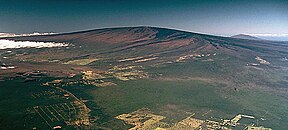Mauna Loa, Hawaii
| Mauna Loa | |
|---|---|

Mauna Loa as seen from the air; Hualālai is visible in the background
|
|
| Highest point | |
| Elevation | 13,679 ft (4,169 m) |
| Prominence | 7,079 ft (2,158 m) |
| Listing | |
| Coordinates | 19°28′46.3″N 155°36′09.6″W / 19.479528°N 155.602667°WCoordinates: 19°28′46.3″N 155°36′09.6″W / 19.479528°N 155.602667°W |
| Geography | |
| Parent range | Hawaiian Islands |
| Topo map | USGS Mauna Loa |
| Geology | |
| Age of rock | 700,000–1 million |
| Mountain type | Shield volcano |
| Volcanic arc/belt | Hawaiian-Emperor seamount chain |
| Last eruption | March to April 1984 |
| Climbing | |
| First ascent | Ancient times |
| Easiest route | Ainapo Trail |
|
Wilkes Campsite
|
|

Sketch by ship's artist Alfred Thomas Agate
|
|
| Nearest city | Hilo, Hawaii |
|---|---|
| Coordinates | 19°27′59″N 155°34′54″W / 19.46639°N 155.58167°W |
| Area | 4 acres (16,000 m2) |
| Built | 1840 |
| Architect | Charles Wilkes |
| Architectural style | Stone shelter |
| NRHP reference # | 74000295 |
| Added to NRHP | July 24, 1974 |
Mauna Loa (/ˌmɔːnə ˈloʊ.ə/ or /ˌmaʊnə ˈloʊ.ə/; Hawaiian: [ˈmɐwnə ˈlowə]; English: Long Mountain) is one of five volcanoes that form the Island of Hawaii in the U.S. state of Hawaiʻi in the Pacific Ocean. The largest subaerial volcano in both mass and volume, Mauna Loa has historically been considered the largest volcano on Earth, dwarfed only by Tamu Massif. It is an active shield volcano with relatively gentle slopes, with a volume estimated at approximately 18,000 cubic miles (75,000 km3), although its peak is about 120 feet (37 m) lower than that of its neighbor, Mauna Kea. Lava eruptions from Mauna Loa are silica-poor and very fluid, and they tend to be non-explosive.
...
Wikipedia


